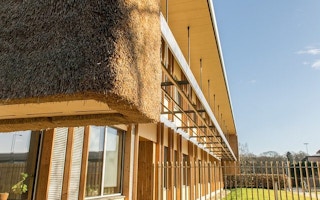Imagine living in a house which heats and cools itself, which saves significantly on energy costs and keeps you healthy and comfortable – and helps to cut greenhouse gas emissions in the process.
The good news is that, in the UK and several other countries, you don’t need to imagine it. Houses as good as that are available to those who can afford them, thanks in large measure to the Passivhaus Trust, an independent non-profit organisation which promotes the principles of low-energy design.
“If you want to get to zero carbon, Passivhaus gets you most of the way there, and a bit of renewable energy finishes the job”, says Jon Bootland, the Trust’s CEO.
The Trust is one of the winners in this year’s Ashden Awards, an annual international competition to encourage sustainable energy. Passivhaus topped the shortlist for the 2017 award for sustainable buildings.
The awards will be presented on 15 June by Al Gore, the former US vice-president turned climate campaigner, at a ceremony at the Royal Geographical Society in London, with each UK winner receiving £10,000 (US$13,300) to support their business (overseas winners receive twice as much).
Ancient forerunners
Passive cooling and heating of houses is a technique that has been used in different parts of the world for thousands of years: one example is the wind towers which are a centuries-old feature of house design in the Middle East.
The Passivhaus secret, an updated version of this ancient tradition, is no great surprise: it’s a range of practical measures, like enhanced insulation, high quality windows, and buildings that are designed to be airtight, with controlled ventilation.
“
If you want to get to zero carbon, Passivhaus gets you most of the way there, and a bit of renewable energy finishes the job.
Jon Bootland, CEO, Passivhaus Trust
They are built with great attention to detail and rigorous design and construction principles, certified through an exacting quality assurance process.
A core part of the Passivhaus standard, obviously, is passive design, which makes the greatest use possible of daylight for lighting, the sun’s warmth for heating in the winter, shading to reduce heating in the summer, and ventilation to provide summer cooling.
With good insulation and close attention to keeping buildings airtight, most homes can be heated for much of the year by a combination of sunlight, waste heat from electrical appliances, and the body heat of occupants.
Ventilation in colder months is provided mechanically, but with a heat recovery system to capture heat from the outgoing air and use it to warm the incoming air. In warmer months occupants often open vents and windows to provide a natural flow of air through the building.
Over 1,000 Passivhaus homes and buildings in the UK are expected to be completed by the end of 2017. Bills for heating and hot water in can be £500-£1,000 a year lower than in normal houses, depending on the size of the home. Annual space heating energy use is limited to 15 kilowatt hours per square meter (15 kWh/m2 per year).
The result is that households in Passivhaus homes are less likely to experience fuel poverty, because their energy bills are so low despite the homes being at a comfortable temperature. More than a quarter of the UK’s energy use and CO2emissions result from domestic energy use, the greater part of it for heating.
Out of reach?
The Trust says there is emerging evidence that health benefits result from Passivhaus homes, probably because the controlled ventilation avoids excessive humidity and high indoor CO2 levels, and the use of filters on the ventilation systems reduces the presence of pollen and particulates within the homes.
Across Europe over 20,000 houses, schools, offices and other buildings have been designed, built and tested to the Passivhaus standard. Meeting those standards often adds to the cost of a new building.
But the technique’s supporters say it is not just something reserved to the well-off. Several housing associations in the UK have been using the standard in housing designed for low-income occupants, because of the benefits it brings to their tenants. Its principles should work as well in tropical countries as they do in temperate Britain.
In eastern England the city of Norwich plans to develop hundreds more Passivhaus homes over the next four years and has worked with the Trust to develop its own training programme, equipping builders to deliver the planned £47 million of Passivhaus construction work.
Norwich’s commitment to eco houses extends beyond the council building projects. In the city the University of East Anglia’s Enterprise Centre, winner of several awards for environmental sustainability, is Passivhaus certified.
The post Passive housing cuts costs – and global warming appeared first on Climate News Network. This story was republished with permission.










